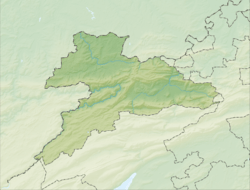Bourrignon facts for kids
Quick facts for kids
Bourrignon
|
||
|---|---|---|
|
||
| Country | Switzerland | |
| Canton | Jura | |
| District | Delémont | |
| Area | ||
| • Total | 13.55 km2 (5.23 sq mi) | |
| Elevation | 770 m (2,530 ft) | |
| Population
(Dec 2020 )
|
||
| • Total | 270 | |
| • Density | 19.9/km2 (51.6/sq mi) | |
| Postal code |
2803
|
|
| Surrounded by | Asuel, Pleujouse, Pleigne, Delémont, Develier, Boécourt | |
Bourrignon is a small town, also called a municipality, located in the Jura canton of Switzerland. It's part of the Delémont district.
Contents
History of Bourrignon
Bourrignon was first mentioned in official records way back in 1136. At that time, it was known as Borognuns. Later, in 1295, its name changed to Burgis. For a while, it also had a German name, Bürkis, but that name is no longer used today.
Geography and Landscape
Bourrignon covers an area of about 13.56 square kilometers (5.23 square miles). A large part of this land, about 65.3%, is used for farming. Forests cover another big portion, about 32.1% of the area.
About 2.4% of Bourrignon's land is built up with buildings and roads. A tiny bit, 0.1%, is made up of rivers or lakes. The rest, also 0.1%, is land that can't be used for farming or building.
The town is located on a flat area, like a terrace, on the northern side of the Les Rangiers mountain chain. This gives it a unique position in the Delémont district.
Town's Official Symbol
The official symbol, or coat of arms, of Bourrignon is quite unique. It shows a silver shield with a green base. From this base, a black castle rises up. This castle has two levels, both with battlements (the notched tops like on a castle wall). The first level has a tower on the left, and the second level has a tower on the right.
People and Population
Bourrignon has a population of about 293 people (as of 2003). In 2008, a small number of people, about 2.5%, were foreign nationals living in the town. Over ten years, from 2000 to 2010, the population slightly decreased.
Most people in Bourrignon speak French as their main language. About 93.7% of the population spoke French in 2000. German was the second most common language, spoken by about 4.9% of the people.
In 2008, the population was almost evenly split between males and females. About 47.9% were male and 52.1% were female. Most residents were born in Bourrignon or elsewhere in Switzerland.
In 2000, children and teenagers (up to 19 years old) made up a big part of the population, about 37.8%. Adults (20-64 years old) made up 50%, and seniors (over 64 years old) were about 12.2%.
The chart below shows how the population of Bourrignon has changed over many years:

Important Sites
The entire village of Bourrignon is recognized as an important heritage site in Switzerland. This means it has special historical or cultural value.
Economy and Jobs
In 2010, the unemployment rate in Bourrignon was low, at 2.3%. Most jobs in Bourrignon are in the primary economic sector, which means jobs related to farming. In 2008, there were 57 people working in this sector.
A smaller number of people work in the secondary sector (like manufacturing) and the tertiary sector (like services). In 2008, 8 people worked in manufacturing, and 10 people worked in services.
Many residents of Bourrignon travel to other towns for work. In 2000, 54 workers left Bourrignon to work elsewhere, while only 7 came into the town for work. About half of the working population used a private car to get to work.
Religion in Bourrignon
According to the 2000 census, most people in Bourrignon are Roman Catholic, making up about 80.1% of the population. A smaller group, about 4.5%, belonged to the Swiss Reformed Church. Some people also belonged to other Christian churches. A small number of people did not belong to any church.
Education System
In Bourrignon, about 26.6% of the population has finished upper secondary education. This is education after the basic required schooling. About 8.4% have gone on to higher education, like university.
The school system in the Canton of Jura, where Bourrignon is located, starts with two years of optional Kindergarten. After that, students attend six years of Primary school. Then comes three years of lower Secondary school, where students are grouped by their abilities.
After lower Secondary, students can choose to go to an optional upper Secondary school for three or four years. They can also go on to higher education or start an apprenticeship to learn a trade.
In the 2009–10 school year, no students were attending school directly in Bourrignon. However, 33 residents of Bourrignon attended schools in other towns.
See also
 In Spanish: Bourrignon para niños
In Spanish: Bourrignon para niños





